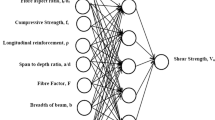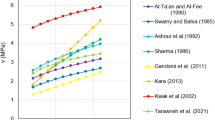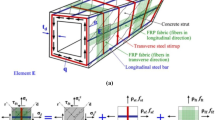Abstract
High-strength concrete (HSC) is currently popular in the design and construction of heavy structures. Being HSC a brittle material, its cracking is sudden and cracks traverse through the aggregate particles thus producing relatively smooth fracture planes which is contrary to the normal-strength concrete (NSC) wherein cracks go around the aggregate particles. The relatively smooth fracture planes in HSC considerably decrease the concrete shear strength by reducing the contribution of the aggregate interlock. However, the international codes for the design of reinforced concrete (RC) structures make no distinction between NSC and HSC and the assessment of shear capacity of slender RC beams without web steel is still based on the experimental data of beams of NSC. In the present research, an effort is made for predicting the shear strength of HSC slender RC beams without stirrups, using regression models and neural networks. A large database of experimental results for HSC slender beams, covering a wide range of influencing parameters, is used for regression analysis as well as for the development of the artificial neural network models. The results of analysis are compared with major code requirements as well as with the researchers’ design model. The regression based as well as the neural network based models are presented. New empirical design models for the two approaches are also suggested.







Similar content being viewed by others
References
Subramanian N (2005) Evaluation and enhancing the punching shear resistance of flat slabs using HSC. The Indian Concr J 79(4):31–37
Ahmad SH, Fareed S, Rafeeqi SFA (2014) Shear strength of normal and light weight reinforced concrete slender beams without web reinforcement. Civil Eng Arch 2(1):33–41
Cuenca E, Serna P (2013) Shear behavior of prestressed precast beams made of self-compacting fiber reinforced concrete. Constr Build Mater 45:145–156
Cuenca E, Serna P (2013) Failure modes and shear design of prestressed hollow core slabs made of fiber-reinforced concrete. Compos Part B 45(1):952–964
Gandomi AH, Alavi AH, Kazemi S, Gandomi M (2014) Formulation of shear strength of slender RC beams using gene expression programming, part I: without shear reinforcement. Automation Constr 42:112–121
American Concrete Institute (ACI). Report on high-strength concrete. ACI 363R-10, American Concrete Institute, Detroit, MI
Hamrat M, Boulekbache B, Chemrouk M, Amziane S (2010) Shear behaviour of RC beams without stirrups made of normal strength and high strength concretes. Adv Struct Eng 13(1):29–41
Gebreyouhannes E, Maekawa K (2011) Numerical simulation on shear capacity and post-peak ductility of reinforced high-strength concrete coupled with autogenous shrinkage. J Adv Conc Tech 9(1):73–88
Maekawa K, Toongoenthong K, Gebreyouhannes E, Kishi T (2006) Direct path-integral scheme for fatigue simulation of reinforced concrete in shear. J Adv Conc Tech 4(1):159–177
Sagaseta J, Vollum RL (2011) Influence of aggregate fracture on shear transfer through cracks in reinforced concrete. Mag Conc Res 63(2):119–137
Carrasquillo RL, Nilson AH, Slate FO (1981) Properties of high strength concrete subject to short-term loads. ACI J Proc 78(3):171–178
Martinez S, Nilson AH, Slate FO (1982) Short-term mechanical properties of high strength light-weight concrete. Research Report No. 82-9, Department of Structural Engineering, Cornell University
Elzanaty AH, Nilson AH, Slate FO (1986) Shear capacity of reinforced concrete beams using high-strength concrete. ACI J Proc 83(2):290–296
Collins MP, Kuchma D (1999) How safe are our large, slightly reinforced concrete beams, slabs, and footings? ACI Struct J 96(4):482–490
Taylor HPJ (1974) The fundamental behaviour of reinforced concrete beams in bending and shear. ACI Special Pub 42:43–78
Sarkar S, Adwan O, Bose B (1999) Shear stress contributions and failure mechanisms of high strength reinforced concrete beams. Mater Struct 32(2):112–116
Taylor HPJ (1970) Investigation of the forces carried across cracks reinforced concrete beams in shear by interlock of aggregate. Technical report 42.447, SBN 721007384, cement and concrete association, London
Mphonde AG (1988) Aggregate interlock in high strength reinforced concrete beams. Structural Engineering Group, Proceedings institution of civil engineers, Part 2 85(3):397–413
Adhikary BB, Mutsuyoshi H (2006) Prediction of shear strength of steel fiber RC beams using neural networks. Constr Build Mater 20:801–811
Elsanadedy HM, Al-Salloum YA, Abbas H, Alsayed SH (2012) Prediction of strength parameters of FRP confined concrete. Compos Part B 43(2):228–239
Elsanadedy HM, Abbas H, Al-Salloum YA, Almusallam TH (2014) Prediction of intermediate crack debonding strain of externally bonded FRP laminates in RC beams and one-way slabs. J Compos Constr. doi:10.1061/(ASCE)CC.1943-5614.0000462
Shah AA, Abbas H, Alsayed SH, Al-Salloum YA, Almusallam TH (2012) Predicting residual strength of non-linear ultrasonically evaluated damaged concrete using artificial neural network. Constr Build Mater 29:42–50
American Concrete Institute (ACI) (2011) Building code requirements for structural concrete and commentary. ACI 318-11, American Concrete Institute, Detroit, MI
Canadian Standards Association (CSA) (2004) Design of concrete structures. CSA A23.3-04, Ontario
Fédération Internationale du Béton (fib) (2012) Model Code 2010—final draft, Vol. 1, Bulletin 65, and Vol. 2, Bulletin 66, Lausanne
European Committee for Standardization (2003) Eurocode 2: Design of concrete structures—Part 1-1: general rules and rules for buildings. Final Draft, prEN 1992-1-1, Brussels
CEB-FIP. Design of concrete structures (1993) CEB-FIP Model Code 1990, Thomas Telford, London
AS 3600-2009 (2009) Concrete structures. Standards Australia International Ltd, Sydney
Japan Society of Civil Engineers (JSCE) (2010) Standard specifications for concrete structures—2007. JSCE Guidelines for Concrete No. 15, Tokyo
Cladera A, Mari AR (2004) Shear design procedure for reinforced normal and high-strength concrete beams using artificial neural networks. Part I: beams without stirrups. Eng Struct 26:917–926
Vecchio FJ, Collins MP (1986) The modified compression-field theory for reinforced concrete elements subjected to shear. ACI J 83–22:219–231
Bentz EC, Vecchio FJ, Collins MP (2006) Simplified modified compression field theory for calculating shear strength of reinforced concrete elements. ACI Struct J 103(4):614–624
Muttoni A (2008) Punching strength of reinforced concrete slabs without transverse reinforcement. ACI struct J 105(4):440–450
Shah A, Ahmad S (2007) An experimental investigation into shear capacity of high strength concrete beams. Asian J Civil Eng 8(5):549–562
Al-Shaleh K, Rahal KN (2007) Shear behavior of K850 reinforced concrete beams with low transverse reinforcement. Kuwait J Sci Eng 34(2B):35–54
Sagaseta J, Vollum RL (2009) Non-linear finite element analysis of shear critical high strength concrete beams. Arch Civil Eng Env 4:95–105
Eisa ASA (2005) Shear strength of high strength concrete beams. MS Thesis, Zagazig University
Ahmad SH, Khaloo AR, Poveda A (1986) Shear capacity of reinforced high-strength concrete beams. ACI J 83(2):297–305
Kim J, Park Y (1994) Shear strength of reinforced high strength concrete beams without web reinforcement. Mag Concr Res 46(166):7–16
Moustafa MT (1999) Behaviour of high strength concrete beams. MS Thesis, Alexandria University
Mphonde AG, Frantz GC (1984) Shear tests of high- and low-strength concrete beams without stirrups. ACI J 81(4):350–357
Pendyala RS, Mendis P (2000) Experimental study on shear strength of high-strength concrete beams. ACI Struct J 97(4):564–571
Shin S, Lee K, Moon J, Ghosh SK (1999) Shear strength of reinforced high-strength concrete beams with shear span-to-depth ratios between 1.5 and 2.5. ACI Struct J 96(4):549–556
Yoon Y, Cook WD, Mitchell D (1996) Minimum shear reinforcement in normal, medium and high-strength concrete beams. ACI Struct J 93(5):576–584
Xie Y, Ahmad SH, Yu T, Hino S, Chung W (1994) Shear ductility of reinforced concrete beams of normal and high-strength concrete. ACI Struct J 91(2):140–149
Cladera A, Mari AR (2005) Experimental study on high-strength concrete beams failing in shear. Eng Struct 27:1519–1527
Perera SVT, Mutsuyoshi H (2013) Shear behavior of reinforced high-strength concrete beams. ACI Struct J 110(1):43–52
Ali S (2001) Flexural and shear behavior of high-strength concrete beams. MS Thesis, University of Engineering & Technology, Taxila
Grimm R (1997) Influence of fracture mechanics parameters on the bending and shear bearing behavior of high-strength concretes. Ph.D. Dissertation, Construction Engineering of the Technical University of Darmstadt, Berlin (In German)
Hallgren M (1994) Flexural and shear capacity of reinforced high strength concrete beams without stirrups. TRITA-BKN. Bull.9, Department of Structural Engineering, Royal Institute of Technology, Stockholm, pp. 1–49
Podgorniak-Stanik BA (1998) The influence of concrete strength, distribution of longitudinal reinforcement, amount of transverse reinforcement and member size on shear strength of reinforced concrete members. MS Thesis, University of Toronto
Morrow J, Viest IM (1957) Shear strength of reinforced concrete frame members without web reinforcement. ACI J 53(3):833–869
Remmel G (1991) For tensile behavior of high-strength concrete and its influence on the shear capacity of slender members without shear reinforcement. Ph.D. Dissertation, Construction engineering of the technical university of Darmstadt, Berlin (In German)
Scholz H (1994) A lateral force support model for components without shear reinforcement at failure of normal strength and high strength concrete. Reports from the Structural Engineering Bulletin 21, Technical University of Berlin (In German)
Drangsholt G, Thorenfeldt E (1992) High strength concrete. SP2—plates and shells. Report 2.1, shear capacity of high strength concrete beams. SINTEF Structural Engineering—FCB, STF70 A92125
Angelakos D, Bentz EC, Collins MP (2001) Effect of concrete strength and minimum stirrups on shear strength of large members. ACI Struct J 98(3):290–300
Adebar P, Collins MP (1996) Shear strength of members without transverse reinforcement. Canadian J Civil Eng 23(1):30–41
Salandra MA, Ahmad SH (1989) Shear capacity of reinforced lightweight high-strength concrete beams. ACI Struct J 86(6):697–704
Islam MS, Pam HJ, Kwan AKH (1998) Shear capacity of high-strength concrete beams with their point of inflection within the shear span. Proc. Inst Civ Eng Struct Build 128:91–99
Kulkarni SM, Shah SP (1998) Response of reinforced concrete beams at high strain rates. ACI Struct J 95(6):705–714
Hallgren M (1996) Punching shear capacity of reinforced high strength concrete slabs. Ph.D. Thesis, KTH Stockholm und TRITA-BKN: Bulletin 23, Stockholm
Hanson JA (1961) Tensile strength and diagonal tension resistance of structural lightweight concrete. ACI J 58(7):1–39
Bukhari IA, Ahmad S (2008) Evaluation of shear strength of high-strength concrete beams without stirrups. Arab J Sci Eng 33(2B):321–336
Bazant ZP, Pfeiffer PA (1986) Shear fracture tests of concrete. Mater Struct J 19(10):111–121
Papanicolaou CG, Triantafillou TC (2002) Shear transfer capacity along pumice aggregate concrete and high-performance concrete interfaces. Mater Struct J 35:237–245
Minelli F, Conforti A, Cuenca E, Plizzari G (2014) Are steel fibres able to mitigate or eliminate size effect in shear. Mater Struct J 47:459–473
Shen J, Yurtdas I, Diagana C, Li A (2015) Experimental investigation on the shear performance of prestressed self-compacting concrete beams without stirrups. Mater Struct J 48:1291–1302
Bažant ZP, Kazemi MT (1991) Size effect on diagonal shear failure of beams without stirrups. ACI Struct J 88(3):268–276
Fathifazl G, Razaqpur AG, Isgor OB, Abbas A, Fournier B, Foo S (2011) Shear capacity evaluation of steel reinforced recycled concrete (RRC) beams. Eng Struct 33(3):1025–1033
Abbas H, Alsayed SH, Almusallam TH, Al-Salloum YA (2011) Characterization of hole-diameter in thin metallic plates perforated by spherical projectiles using genetic algorithms. Archive Appl Mech 81(7):907–924
Gandomi AH, Yun GJ, Alavi AH (2013) An evolutionary approach for modeling of shear strength of RC deep beams. Mater Struct 46:2109–2119
Elsanadedy HM, Haroun MA (2005) Seismic design guidelines for squat composite-jacketed circular and rectangular reinforced concrete bridge columns. ACI Struct J 102(4):505–514
Elsanadedy HM, Al-Salloum YA, Alsayed SH (2013) Prediction of punching shear strength of HSC interior slab-column connections. KSCE J Civil Eng 17(2):473–485
Kani GNJ (1966) Basic facts concerning shear failure. ACI J Proc 63(6):675–692
Iguro M, Shioya T, Nojiri Y, Akiyama H (1985) Experimental studies on shear strength of large reinforced concrete beams under uniformly distributed load. Japan Society of Civil Engineers (JSCE). Concr Libr 5:137–154
Zararis PD, Zararis IP (2008) Shear strength of reinforced concrete beams under uniformly distributed loads. ACI Struct J 105(6):711–719
Reineck K-H, Bentz E, Fitik B, Kuchma DA, Bayrak O (2013) ACI-DAfStb databases for shear tests on slender reinforced concrete beams with stirrups. ACI Struct J 110(5):867–876
Caldentey AP, Padilla P, Muttoni A, Ruiz MF (2012) Effect of load distribution and variable depth on shear resistance of slender beams without stirrups. ACI Struct J 109(5):595–603
Acknowledgments
The Authors would like to extend their sincere appreciation to the Deanship of Scientific Research at King Saud University for its funding of this research through the research group project No. RGP-VPP-104.
Author information
Authors and Affiliations
Corresponding author
Rights and permissions
About this article
Cite this article
Elsanadedy, H.M., Abbas, H., Al-Salloum, Y.A. et al. Shear strength prediction of HSC slender beams without web reinforcement. Mater Struct 49, 3749–3772 (2016). https://doi.org/10.1617/s11527-015-0752-x
Received:
Accepted:
Published:
Issue Date:
DOI: https://doi.org/10.1617/s11527-015-0752-x




